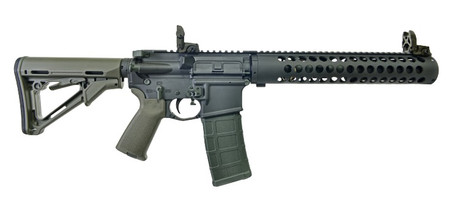How to Legally Build an SBR
Posted by Gun Builders Depot on Jul 14th 2021
The ATF is trying to ban the use of pistol braces. Although braces won't be banned, installing one on your AR-15 will, in most cases, cause it to be defined as a short-barreled rifle (SBR). This is illegal to own without filing paperwork with the ATF under the National Firearms Act (NFA). Today, we're going to show you how to legally build an SBR.
Questions About Building an SBR
Q: Why is my AR-15 pistol likely to be redefined as an illegal SBR?
A: At the direction of the Biden administration, the ATF developed a (useless) set of guidelines that they will apply to AR-type pistols equipped with stabilizing braces. The guidelines use a complicated and arbitrary "points system." If a firearm being analyzed accrues too many points, it will be considered an SBR. Examples of pistols that will automatically be considered SBRs include any braced pistol equipped with virtually any sights or optics, and any braced pistol weighing more than 120 ounces, or 7.5 pounds.
Q: Can I legally convert my AR-15 pistol into an SBR?
A: Yes! In doing so, you get to avoid dealing with the ATF's ever-increasing practice of making up useless, convoluted regulations that don't actually do anything meaningful. We're going to show you how to do that in this guide.
Q: Can I build an un-braced AR pistol and convert it?
A: Yes. That's exactly what we're detailing in this guide: If the ATF gets their way, you'll still be able to build an AR-15 pistol - chances are, you'll just have to skip installing a pistol brace. Once your SBR application is approved, you can slap on a buttstock and enjoy your new SBR.
Q: Can I convert a rifle I own or build into an SBR?
A: Yes. The process is like converting a pistol. Except in this case, you get to keep your buttstock but you can't install a barrel shorter than 16" until your application is approved.
Q: How do I get approval to build an SBR?
A: The process is similar to purchasing any firearm from an FFL: You must fill out an application, wait for a background check to clear, and then you'll receive an approval. The only major difference in obtaining approval for an NFA item is the requirement of mailing in a set of fingerprints. That part is relatively easy. We'll cover how to do that in detail.
Q: What is this application, exactly?
A: The ATF runs a website called eForms. This website is used to process applications to buy or build NFA-type firearms. On that website, you will make an account. Once registered, you'll be able to digitally apply to build your SBR using what's called Form 5320.1, or a "Form 1" application.
Q: How long does it take to get approval to build an SBR?
A: The current wait times vary between 21 to 90 days. Most Form 1 applicants who are approved wait approximately 30 days. The application process and approval is electronic, save for mailing in prints.
Q: What is the difference between a rifle, pistol, and SBR?
A: A short-barreled rifle is equipped with a buttstock (and perhaps soon, a brace that's considered a stock) and a barrel measuring less than 16" in length. A rifle with a buttstock and barrel measuring 16" but with an overall length less than 26" is also considered an SBR.
Q: I heard you must engrave your SBR, is that true?
A: Yes. After your application's approved, your SBR's receiver will need to be engraved with some basic information, like your name, city state, and the firearm's model name, caliber, and serial number. If you're converting an AR-15 that's already engraved with a model, caliber, and serial number, you only need to add your name, city and state. We'll cover this more.
How to Legally Build an SBR
1. Decide on Your Rifle's Configuration

When you apply to build your SBR, you'll need to provide some information about your future rifle. That includes barrel length, caliber, and overall length. You'll need to finalize what your SBR will look like before applying. This is the fun part: You can build your future SBR as a pistol first, and legally own and use that firearm before approval. You just can't install a buttstock.
2. Pick Your Receiver: 80% or Stripped
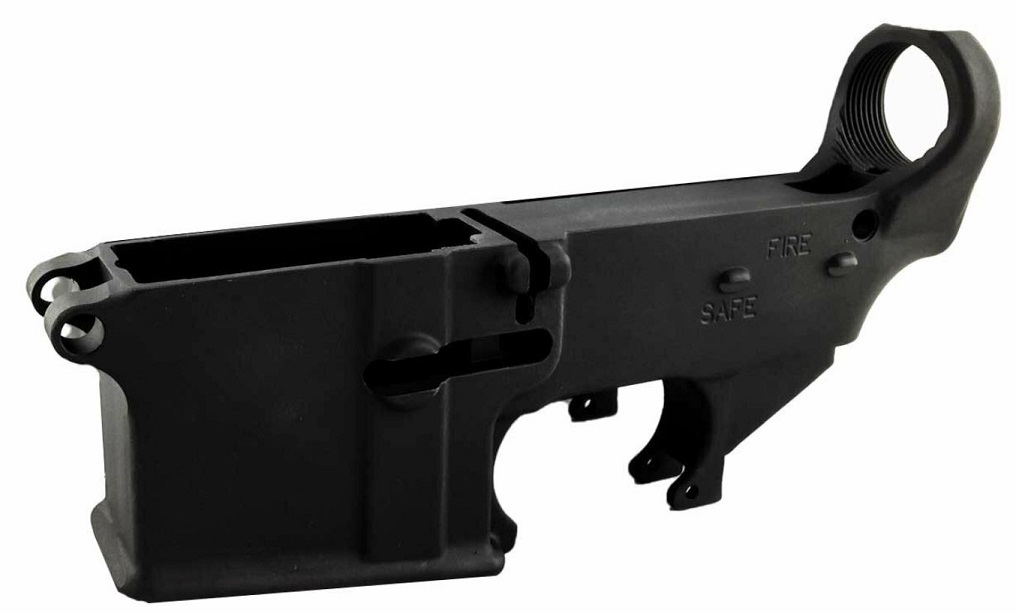
If you build your SBR using a pre-engraved receiver (a serialized, stripped lower from an FFL) then it makes the application easier, and the engraving process a little more affordable. You could use an 80% lower you already fabricated, and this will allow you to come up with any model name and serial number you desire. Of course, you may opt to not use an 80% lower since adding such information to the lower might negate the benefits of owning it in the first place.
3. Submit Your SBR's Form 1 Application

Once you've finalized your SBR's general configuration, you can submit the application to build it or convert your existing AR. To get started, make an account on the eForms website. After making your account, log in and find the form labeled "FORM 1 ATF F 5320.1". Click on it. This is the application to build an NFA firearm.
Want help filing the application? Follow our in-depth guide.
How to file the Form 1 Application, start to finish.
4. Record and Mail your Fingerprints
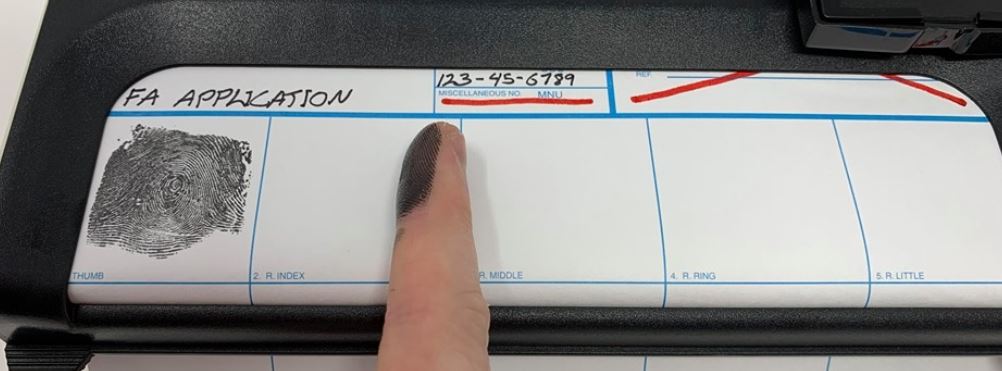
After submitting your Form 1 application, you'll need to record two sets of inked fingerprints on FD-258 Fingerprint Cards. You'll mail these cards to the ATF using a letter they email you (called a Cover Letter) shortly after submitting the application.
Here's a full guide on how to record your fingerprints on FD-258 cards.
5. Wait for Approval
Now that your application and fingerprints are submitted, all you can do is wait. For applications to make and register a firearm, the ATF says the average wait time is 60 days. We've found that it's typically closer to 30 days, but it can sometimes take up to 90 days. Once your application is approved, you'll receive an email notifying you. In that approval email, you'll receive a digital copy of your NFA Tax Stamp. It'll look like this:
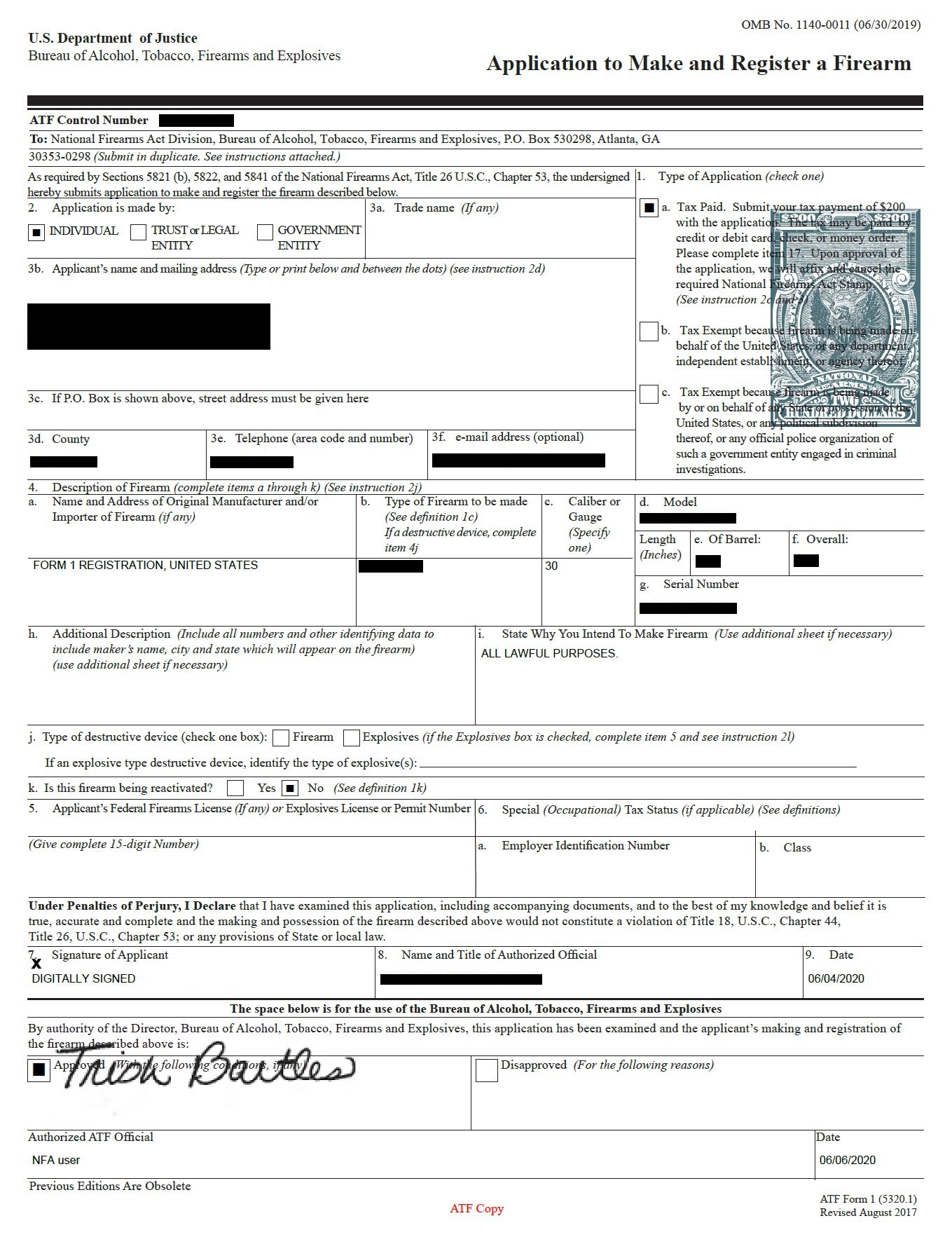
6. Engrave your Receiver
You should wait to engrave your future SBR's receiver until the application is approved. Once approved, you can engrave the receiver yourself, or you can have a local gunsmith do it for you. Most gunsmiths who advertising engraving services already know what needs to be done with NFA engravings. You'll just need to provide them with your SBR's information. Give them a copy of your approved form, as shown above.
7. Complete Your SBR!
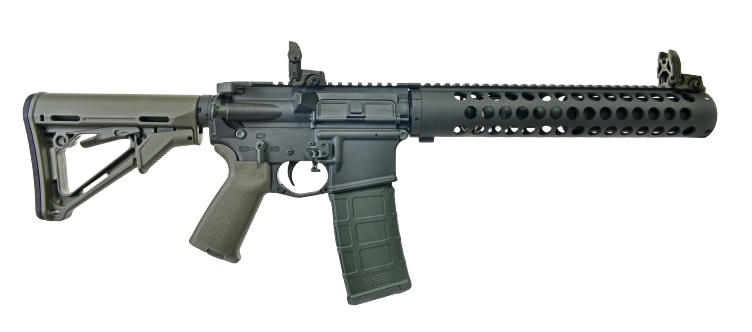
With an approved application and engraved receiver, you're now the proud owner of a short-barreled rifle. At least on paper, that is. Now you can finally install your buttstock (or pistol brace, if you were enjoying your converted AR pistol's old configuration) and hit the range. No more playing jump-rope with the ATF's bureacracy and flip-floppy rules!
DISCLAIMER: If you are new to the world of DIY gun building, you likely have a lot of questions and rightfully so. It’s an area that has a lot of questions that, without the correct answers, could have some serious implications. At GunBuilders.com, we are by no means providing this content on our website to serve as legal advice or legal counsel. We encourage each and every builder to perform their own research around their respective State laws as well as educating themselves on the Federal laws. When performing your own research, please be sure that you are getting your information from a reliable source.

